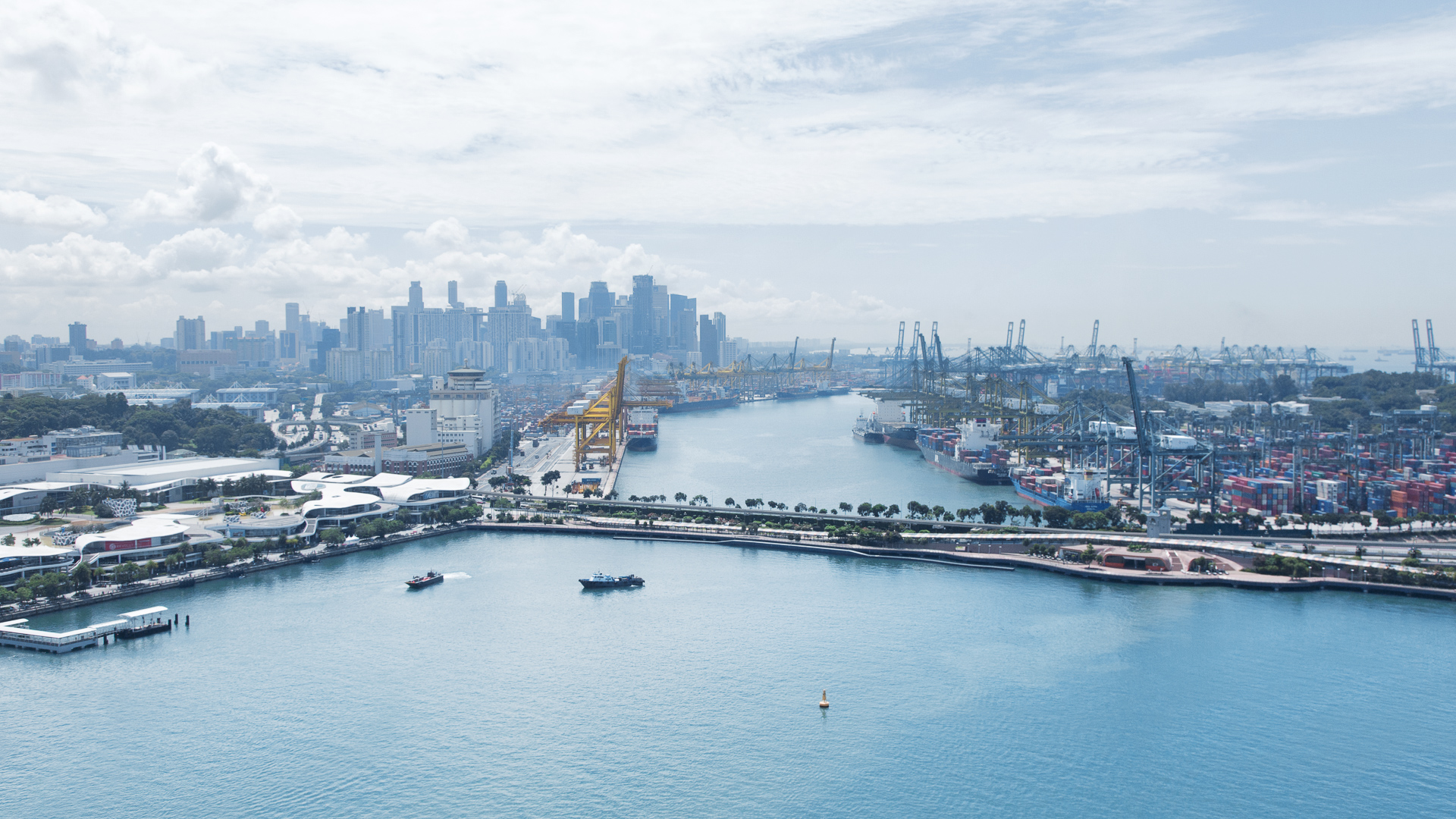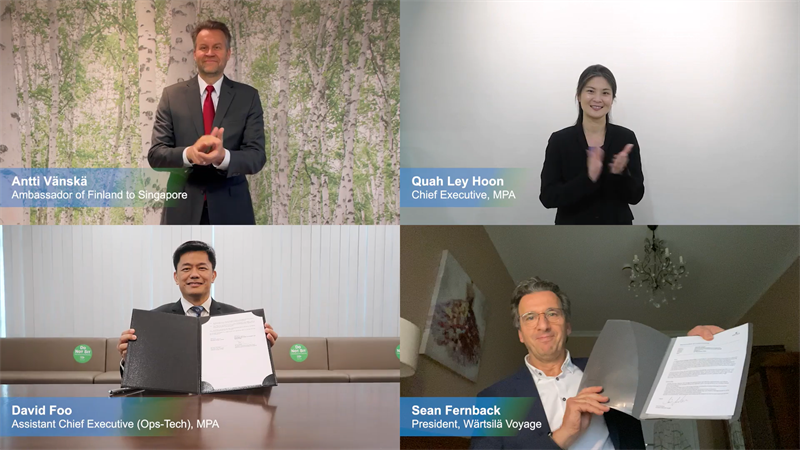

Strategically located on the East-West trade lane, and boasting connectivity to 600 ports in 123 countries, Singapore has kept its position as the leading maritime city of the world during the pandemic and emerged as a green transformation leader.
The 2022 edition of the Leading Maritime Cities (LMC) report by DNV and Menon Economics has named Singapore the #1 among the top 50 maritime cities worldwide. The report benchmarked all these cities under five categories – Shipping Centers, Maritime Technology, Ports and Logistics, Attractiveness and Competitiveness and Maritime Finance and Law – and found Singapore among the top five in the first four categories. In fact, it ranked in the top three for Ports and Logistics and outperformed all other cities in Maritime Technology and Attractiveness and Competitiveness categories. “We are quite certain that cities taking the lead in the green transformation will become the leading maritime cities of the world,” said the LMC report analysis.
Singapore is also at the forefront of setting up frameworks for maritime R&D projects. The city has set itself the bold target of housing 150 start-up companies in the maritime technology sector and is dubbed the Silicon Valley of maritime technology 2025.
“The government is willing to provide support schemes to maritime companies, especially maritime technology start-ups, to increase their ease of access to markets, funding, and talent,” the report noted. One such program is the PIER71, set up by the Maritime Port Authority of Singapore (MPA), which strives to create an international ecosystem of maritime technology providers, investors, and start-ups to accelerate the exchange of knowledge and ideas, boosting innovation in the maritime industry.

Considering our long-term partnership with MPA to co-develop next-generation safer and greener smart port solutions, Wärtsilä Voyage sat down with Kenneth Lim, Assistant Chief Executive (Industry), at MPA to discuss their strategies and actions that have led to Singapore’s success so far, as well as their plans for the future.
Wärtsilä Voyage (WV): The maritime industry is amidst a digital transformation. This is particularly relevant for Singapore, as it ranked number one among global maritime cities in this area. Could you share your thoughts on Singapore’s continued success?
Kenneth Lim (for MPA): Singapore’s continued success as a global maritime and trade hub relies on how efficiently it can move goods through its port. As our port expands its capacity, so will the demand for port operations. Digitalisation plays a vital role to reduce “frictions” in this flow of goods. Capturing, processing, and sharing data and insights will provide significant productivity gains. Therefore, MPA has rolled out several digital initiatives to enhance our port's efficiency, productivity, and resiliency by working closely with key partners and stakeholders. These include the electronic Bunker Delivery Note and the electronic Bill of Lading to facilitate trusted and secure data sharing between supply chain ecosystem partners.
A new digital platform – Portal for Regulatory Transactions or digitalPORT@SG™ - was launched by MPA in October 2019 as a one-stop clearance for vessel-related transactions to enhance ship turnaround time and cut greenhouse gas emissions from ships by reducing their dwell time at anchorage. In its first phase, digitalPORT@SG™ has already helped shippers save approximately 100,000 person-hours per year by streamlining voluminous paperwork and regulatory transactions.
Further, to strengthen port-to-port connectivity and efficient trade transactions, MPA also launched digitalOCEANS™ in November 2021. Here, individual data platforms of port authorities, port operators, shipping lines, logistics companies and platform providers can exchange data and interoperate through a common set of APIs to create a seamless cross-border global digital network.
Beyond the port ecosystem, we support maritime service providers on their digital journey. MPA has developed a Maritime Digitalisation Playbook with Singapore Shipping Association (SSA) and other stakeholders in the maritime innovation ecosystem. We also provide incentives to encourage SMEs to embark on their digitalisation transformation. Another critical aspect of technological transformation is collaborating with stakeholders on common challenge statements. This is done through the Maritime Innovation Challenge, which brings together maritime corporates and thought leaders to identify real-world challenges.
Ultimately, committed and capable men and women will underpin our digitalisation aspirations. We, therefore, must continue to make a career in the maritime sector an attractive and exciting one. We are also working with our industry partners, including the Singapore Maritime Foundation (SMF) and institutes of higher learning to grow and nurture the talents to lead and sustain this transformation for many years to come.
WV: Singapore is considered to have one of the best port and logistics services, where the Singapore government, MPA and PSA, and all other supporting associations are aligned. In your opinion, how important has this alignment been to Singapore’s success?
MPA: The foundation of Singapore’s success as a leading maritime city is centred on the strong tripartite partnership between the government, industry, and unions. The Covid-19 pandemic has demonstrated the resilience of Maritime Singapore, with our trilateral partners working together to keep our ports open and supply chain flowing, while keeping our workers and Singapore safe.
Take, for instance, international crew change. Knowing the critical role of seafarers in keeping global supply chains open, MPA established the Shipping Tripartite Alliance Resilience Fund (STAR Fund) with Singapore Shipping Association (SSA), unions and international organisations to ensure that crew changes are conducted safely amongst seafaring nations. As a result, between March 2020 and December 2021, Singapore facilitated 210,000 crew changes. By the end of February 2022, the number is expected to be close to 230,000.
On the port operations front, the development of the Tuas project has also continued to remain on track despite the disruptions caused by the pandemic because of the tripartite efforts to minimise the spread of infection among the workers.
WV: MPA has also put tremendous focus on R&D as one of its core pillars. Could you briefly tell us about its strategic importance?
MPA: Our ability to leverage technology and innovate novel solutions is key to ensuring that we can be future-ready as a global hub port.
MPA is developing the Next Generation Vessel Traffic Management System to uphold high levels of navigational safety by leveraging real-time information and AI capabilities to provide richer and more timely advisory information to vessels calling on our port.
Partnering with the marine ecosystem, MPA is also actively supporting technology developments for Maritime Autonomous Surface Ships (MASS) aimed at developing local capabilities in MASS vessel design and guidelines for MASS trials in port. One such project is the IntelliTug project that MPA and Wärtsilä Voyage had collaborated on alongside PSA Marine, Lloyd’s Register and the Technology Centre for Offshore and Marine Singapore.

Further, MPA works closely with Singapore Maritime Institute (SMI) to develop strategic research programmes such as the Maritime Transformation Programme to maintain our port's competitiveness. This supports key capabilities areas like robotic platforms for automated coning/de-coning, decentralised vehicle fleet management to support large fleet operations at the terminal, digital intelligence for efficient navigation and more.
Moreover, SMI and MPA have funded four maritime research centres of excellence (CoEs) to build a sustainable pool of research specialists. The CoEs have built deep domain expertise in port modelling and simulation, maritime navigation and operation safety, maritime energy and sustainability and MASS capabilities.
WV: Singapore is also a leading centre for sustainable technologies. What are some of the key upcoming projects in this area?
MPA: With climate change on the global agenda, decarbonisation is now a significant priority for the shipping industry. Together with six industry partners – BW Group, BHP, Eastern Pacific Shipping, Foundation Det Norske Veritas, Ocean Network Express, and Sembcorp Marine – MPA set up the Global Centre for Maritime Decarbonisation (GCMD) in August 2021 to reduce greenhouse gas emissions, implement identified decarbonisation pathways, and create new business opportunities for the industry. The GCMD will also collaborate with partners around low or net-zero emission projects and programmes, including knowledge sharing, data analytics, and green corridors development.
Moreover, to ensure that we meet the IMO’s 2050 target, Singapore is also leading efforts to promote greener fuels such as liquefied natural gas (LNG) as a viable and clean transitional marine fuel. Guided by the Maritime Singapore Decarbonisation Blueprint 2050, the Port of Singapore will also support the decarbonisation of international shipping through a multi-fuel transition, including ammonia bunkering.
We also have co-funded projects on the electrification of harbour crafts, bringing in researchers, technology partners, harbour craft operators and shipyards together to catalyse new solutions to be commercialised.
WV: MPA recently signed a strategic partnership with Wärtsilä Voyage, where the two will specifically work towards enabling Just-In-Time (JIT) operations supporting sustainable shipping. Could you tell us a bit more about this?
MPA: Under this MoU, both parties will embark on a new data-sharing collaboration that facilitates interoperability between MPA’s one-stop portal for arriving ships, digitalPORT@SG™ and Wärtsilä Voyage’s Navi-Port shipboard system to enable timely vessel arrival to the Port of Singapore for JIT operations. Operational timestamps will be exchanged via Application Programming Interfaces (APIs), allowing for greater visibility of vessels’ estimated arrival time to plan port resources efficiently.

Image caption: Antti Vänskä, Ambassador of Finland to Singapore; Quah Ley Hoon, Chief Executive, MPA; David Foo, Assistant Chief Executive (Ops-Tech), MPA; Sean Fernback, President, Wärtsilä Voyage. From the virtual signing ceremony at the Smart Port Challenge 2021. © Wärtsilä
WV: Systematic and secure data sharing along with contractual obligations is often seen as a barrier to JIT’s operational implementation. How is MPA tackling these challenges?
MPA: Timely, reliable, and accurate information sharing remains critical and essential in facilitating JIT arrivals and operations. MPA will play an important coordination role amongst our port stakeholders making such information available on the JIT platform. It is essential for stakeholders to have such transparency from a port authority.
We also recognised that contractual barriers might cause ship owners/operators to avoid practising JIT arrivals. MPA will continue to work with the maritime community to collectively explore other technology advancements to mitigate and eliminate any risks and concerns regarding JIT arrivals.
WV: The collaboration between Wärtsilä Voyage and MPA will also foster the interoperability of e-Navigation tech. How will this strengthen MPA’s port operations in the future?
MPA: International organisations such as IMO and IALA have identified future maritime services such as Local Port Services and Vessel Shore Reporting under e-Navigation. The interoperability of e-Navigation tech will help enhance the productivity of vessel and port operations through timely data exchange. With the development of future communications systems such as VHF Data Exchange System and JIT operations, seamless and secured data exchange, advanced planning, and optimisation could occur before the vessels’ arrival. This will, in turn, reduce the amount of waiting time of ships in port, leading to a faster turnover rate and greater operational efficiency.
WV: Out of five, three of the top global maritime cities are now in Asia. So, not only is the gap between Europe and Asia closing, but we are witnessing an industry-wide tectonic shift – your thoughts?
MPA: These transformations align with the global directions our shipping lines, ports and maritime services are taking. And these transformations require all stakeholders, from around the world, to collaborate and move the industry forward. From our side, Singapore continues to work closely with like-minded global partners and industry players to advance our digitalisation and decarbonisation efforts as we build a solid economy in the new normal and beyond.


